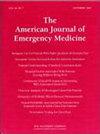The perception of gender and the approach taken towards female physicians
IF 2.7
3区 医学
Q1 EMERGENCY MEDICINE
引用次数: 0
Abstract
Aim
The aim of this study is to evaluate gender perception among patients in the emergency department (ED) and to examine the effect of gender perception on patients' preference of physician's gender.
Methods
This was a cross-sectional survey study. The survey comprised three sections. The first section collected general information, while the second section inquired about patients' preferences for physicians' gender in the ED, in general examinations, and regarding “sensitive” medical issues. The third section of the survey, entitled the “Perception of Gender Scale,” comprised a series of questions designed to assess the participants' perceptions of gender. The scale employed a Likert-type response format, with scores ranging from 25 to 125. Higher scores indicated a more egalitarian gender perception.
Results
The number of participants in the study was 431, with 194 males and 237 females. The median age of the participants was 38.5 years (interquartile range [IQR] 28–48). Over half of the participants had completed university education. The study population exhibited a Perception of the Gender Scale (PGS) score of 96 (IQR 78.5–109). With regard to the patient's preference for physicians' gender, in emergency settings (ES) and in general examinations (GE), over three-quarters of the participants indicated that they do not have a preference. However, for sensitive medical issues (SMI), the proportion of participants indicating no preference decreased to 45 %. Among those with the lowest quartile of PGS scores, the percentage of individuals who expressed no gender preference in ES, GE and SMI was 65 %, 60 %, 26 % and who expressed a preference for male physicians was 13 %, 19 %, 43 % respectively. In contrast, of those with the highest quartile of PGS scores, the percentages of those who had no gender preference were 86 %, 90 %, 68 %, while the percentages of those who preferred male physicians were 1.9 %, 1 %, and 4.8 %, respectively.
Conclusion
In the context of emergency settings and general examinations, approximately three-quarters of the participants indicated no preference regarding the gender of the physician. However, in the case of sensitive medical issues, the proportion of participants with no gender preference was less than half. For patients with a gender preference for their physician, perception of gender is a significant predictor.
性别观念和对女医生的态度。
目的本研究旨在评估急诊科(ED)患者的性别认知,并探讨性别认知对患者对医生性别偏好的影响。调查包括三个部分。第一部分收集一般信息,第二部分询问患者在急诊室、一般检查和 "敏感 "医疗问题上对医生性别的偏好。调查的第三部分名为 "性别认知量表",由一系列问题组成,旨在评估参与者对性别的认知。该量表采用李克特(Likert)型回答格式,分值从 25 分到 125 分不等。结果参与研究的人数为 431 人,其中男性 194 人,女性 237 人。参与者的年龄中位数为 38.5 岁(四分位数间距 [IQR] 28-48)。超过半数的参与者完成了大学教育。研究对象的性别认知量表(PGS)得分为 96(IQR 78.5-109)。关于患者对医生性别的偏好,在急诊环境(ES)和普通检查(GE)中,超过四分之三的参与者表示没有偏好。然而,在敏感医疗问题(SMI)方面,表示没有偏好的参与者比例降至 45%。在 PGS 分数最低的四分位数参与者中,对 ES、GE 和 SMI 没有性别偏好的比例分别为 65%、60% 和 26%,对男医生有偏好的比例分别为 13%、19% 和 43%。相比之下,在 PGS 分数最高的四分位数中,无性别偏好者的比例分别为 86%、90% 和 68%,而偏好男医生者的比例分别为 1.9%、1% 和 4.8%。然而,在敏感的医疗问题上,没有性别偏好的参与者比例不到一半。对于对医生性别有偏好的患者来说,性别认知是一个重要的预测因素。
本文章由计算机程序翻译,如有差异,请以英文原文为准。
求助全文
约1分钟内获得全文
求助全文
来源期刊
CiteScore
6.00
自引率
5.60%
发文量
730
审稿时长
42 days
期刊介绍:
A distinctive blend of practicality and scholarliness makes the American Journal of Emergency Medicine a key source for information on emergency medical care. Covering all activities concerned with emergency medicine, it is the journal to turn to for information to help increase the ability to understand, recognize and treat emergency conditions. Issues contain clinical articles, case reports, review articles, editorials, international notes, book reviews and more.

 求助内容:
求助内容: 应助结果提醒方式:
应助结果提醒方式:


